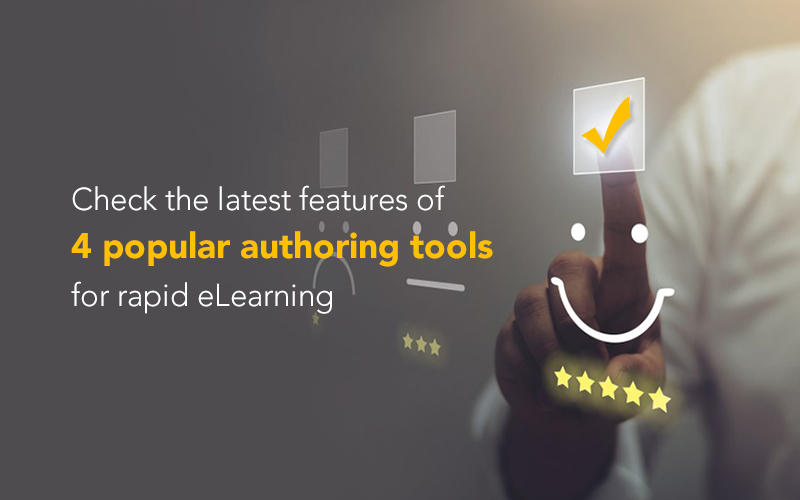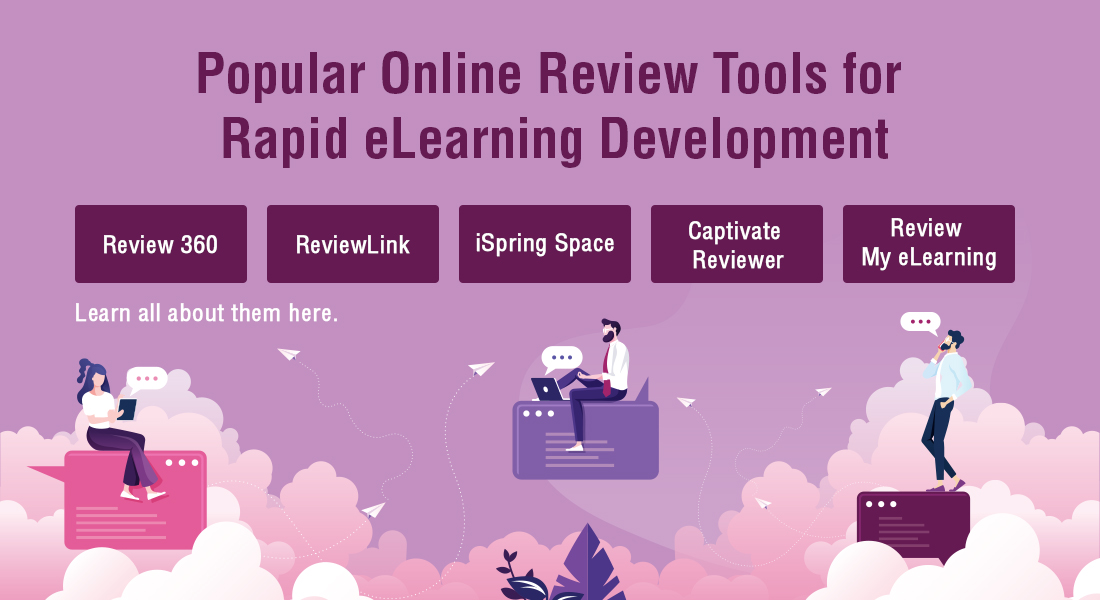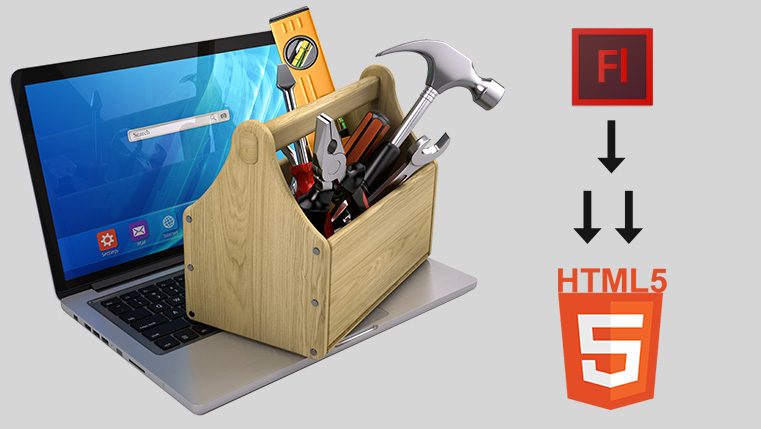4 Popular Authoring Tools for Rapid eLearning Development

I have a question for you. What do you reckon an average training manager wants while investing in an eLearning program? Low cost, swift turnaround time, easy development, right? Do you know one way of achieving all three at once? Rapid eLearning! It’s the process of developing online training courses by cutting down development time and cost using authoring tools.
Popular Authoring Tools for Rapid eLearning
Explore the latest of:
- Adobe Captivate
- Articulate 360
- Storyline 360
- Rise 360
- Lectora Inspire
- iSpring Suite
What is an Authoring Tool?
An authoring tool is a software to develop eLearning courses without any coding or programming skills. For years, Adobe Flash was the most widely used authoring software giving every other tool run for its money. But with its imminent phase-out by the end of 2020, authoring tools that can produce HTML5 output are now in high demand. But amidst this parade, which authoring tool should you place your bet on?
Truthfully, when it comes to choosing the right authoring tool, the choice is not always simple. Most authoring tools have pretty much the same basic features. And yet, there is always one unique feature in each tool that makes it best suited for your training requirements.
So, to help you make the right choice, here is a list of the most popular authoring tools in the market for rapid eLearning development.
→ Access Now: Authoring Tool Finder
Top Authoring Tools for Rapid eLearning
Adobe Captivate
Flash may have left the arena, but Adobe is still in the race for best authoring tools with its latest version of Captivate 2019. From developing mobile responsive courses to Flash to HTML5 conversions to simulations, Captivate is the apt tool for rapid eLearning development if you need a highly interactive and immersive training experience.
Here are a few features that make Adobe Captivate worth your choice.
You can design an eLearning course that gives learners an immersive learning experience using 360° images and virtual reality. Captivate has inbuilt VR templates which eliminate the need for extensive programming needed to develop such courses. All you need to do is record a 3D image or use a 360-image from the library and import it into the VR templates.
You can transform a boring and passive video into a highly interactive video using the slides overlay feature. All you need to do is select the slide in which the video needs to be placed, choose the ‘interactive video’ option from the toolbar, and import a video from YouTube or an MP4 file from your system.
Once this is done, place an overlay slide consisting of a knowledge check or question at a specific location on the video. Thus, a mere watch-only video can be changed into an engaging eLearning video in a jiffy.
You can develop videos with live-action web-cam recordings in an on-screen simulation. All you need to do is record a video of yourself using a webcam app, whose background can be removed or made transparent using the chroma key effect (another Captivate feature), and import it to a simulation template.
The best of all features from Adobe Captivate is its Fluid Box 2.0. These fluid boxes are responsible for mobile responsive courses as they allow a seamless transition of content across device sizes and orientations.
Articulate 360
The Articulate suite is inarguably one of the most widely used rapid eLearning authoring tools in the market today. Most eLearning developers love this tool because it can create a range of eLearning courses from low to high interactivity. It also has a really low learning curve because the interface is very similar to that of PowerPoint.
The suite comes up with a variety of apps out of which two are powerful authoring tools and here is what each of these offers you for rapid eLearning development.
Storyline 360
Storyline is a hot favorite for developers while creating animations or scenario-based eLearning courses. It has a library of 5 million multimedia assets such as characters, images, interactivities, and templates, which give developers an unlimited supply of copyright-free media assets. To top that, the templates are highly customizable. Storyline can create high-quality animations because it allows developers to put ten different motion paths and triggers on objects.
Rise 360
Now imagine you have readily available ILT materials – manuals, PDFs, and PPT decks. You need to convert these to eLearning courses of level 1 or level 2 interactivity. In this case, there is no point in using the nuanced interactivities offered by Storyline 360. You can just use Rise 360, a cloud-based authoring tool from the same Articulate family to develop such courses.
But why Rise 360? Because there is no need to install it; no learning curve for developers. All they need to do is place the content in the in-built learning blocks. Learning blocks can be for text, image, statements, quotations, lists, and more. These blocks are highly flexible and move around to create a specific layout for a fully responsive eLearning course.
So, if you’re looking to develop an interactive, mobile-first eLearning program; you can’t go wrong with Articulate Rise.

Lectora Inspire
If there is one authoring tool that truly can generate fully responsive mobile learning courses, it’s Lectora Inspire. Its RCD (Responsive Course Design) feature makes it the first pick for organizations with BYOD (Bring Your Own Device) policy and mobile-first eLearning strategies. Lectora Inspire is also one of the choicest tools when it comes to Flash to HTML5 conversion. Un-wieldy, mobile-incompatible course Flash courses can easily be converted into mobile-friendly eLearning courses using the RCD feature.
Tools such as Camtasia and Snagit come as part of the Lectora Suite which allows developers to record their old Flash courses to the MP4 format, add assessments, and publish them as HTML5 courses. The BranchTrack feature enables the development of branching scenarios without needing any coding.
One of the best features of Lectora is its multilingual switchable interface which makes it extremely translation-friendly. This feature enables rapid eLearning course development in multiple languages, even languages with right-to-left script. It also allows learners to switch languages at any point in the course.
Lectora launched a cloud-based authoring tool similar to Inspire in 2020 – Lectora Online. This tool allows collaborative authoring which helps in cutting down further time for rapid eLearning course development.
iSpring Suite
When it comes to top authoring tools, iSpring is one of the most easy-to-use and agile authoring tools. It truly lives up to the name and objective of a rapid eLearning authoring tool. It reduces the time, effort, and resources needed for courseware development and yet can produce highly interactive courses.
You hardly need any training to use iSpring because it’s a PowerPoint plug-in. So if you have ILT materials full of PPT decks, you can convert them to interactive eLearning courses in a jiffy using iSpring. This tool isn’t just for programmers and developers but is designed keeping instructional designers in mind. Instructional designers don’t have any technical expertise but iSpring authoring tool enables them to develop interactive eLearning courses on their own.
The new iSpring Suite 11 launched on September 01, 2022, has all reasons to fall in love with it. The updated version is more user-friendly and visually appealing with readymade player themes and a versatile library of characters and backgrounds. The tool’s content library offers hand-drawn characters and backgrounds that can help you design interactive courses. You can also play around with stuff like the shape of buttons, fonts, and add gradients, or adjust transparency.
Have more questions on rapid eLearning? Watch this video to get answers to 5 common FAQs.
Summing It Up
So now that you have a rough idea of what each of these rapid authoring tools offer, are you ready to make your choice? But here’s a suggestion you shouldn’t overlook – you should never make the decision regarding authoring tools without consulting your instructional designers and developers. After all, the tool is only as good as the people using it. So go ahead and set up a meeting with your rapid eLearning experts to discuss and choose the right authoring tool. And to help you make the right choice, here’s the authoring tool finder that will come in handy. Leverage the tool to pick the one that’s just right for your business.
Editor’s note: This post was originally published in March 2021 and has been updated for comprehensiveness.





